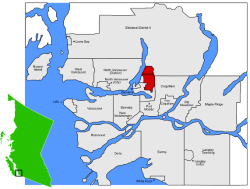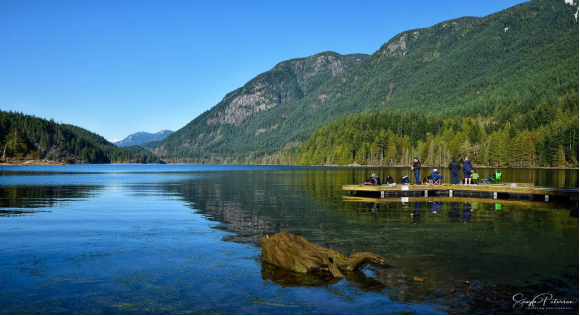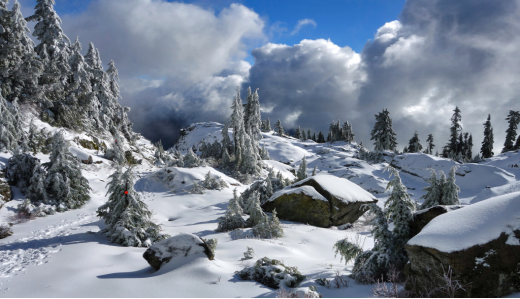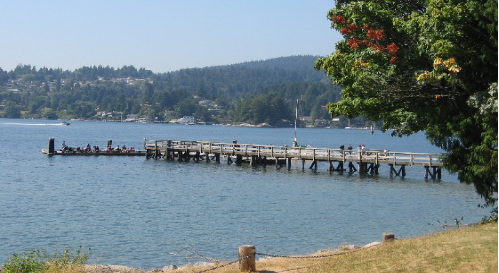Belcarra, British Columbia 作者: 来源: 发布时间:2021-03-29
I. Population and Area
₋ Area
Land: 5.50 km2 (2.12 sq mi)
₋ Population (2016)
Total: 643
Density: 116.9/km2 (303/sq mi)

II. Natural Geography
₋ Belcarra is a village on the shore of Indian Arm, a side inlet of Burrard Inlet, and is part of Metro Vancouver. It lies northwest of Port Moody and immediately east of the Deep Cove area of North Vancouver, across the waters of Indian Arm. Isolated by geography on a narrow peninsula, Belcarra is accessible by a single winding paved road or by water. Before incorporation it was commonly known as Belcarra Bay.
₋ It is largely a residential bedroom community for Vancouver and its suburbs. Belcarra is the only community in this area that is not growing substantially. While the small neighbouring Village of Anmore has grown and changed, Belcarra has remained a relatively small community. This is a result of small land area and zoning for single family residential homes. With a population of 643 as of 2016, it has the lowest population of any independent settleme nt in the Vancouver area. Many residents in Belcarra have private docks and boats; even houses that are not on the water are sometimes able to procure a shared dock. Belcarra Regional Park winds its way through the village.

₋ Transportation:
As part of Metro Vancouver, Belcarra is served by the TransLink public transit system, and is on bus route 182.
III. ECONOMY
₋ The median income for a household in the village was $100,995, and the median income for a family was $105,016. Males had an average income of $61,200 versus $34,840 for females.
IV. Industrial Characteristics
₋ Website: http://www.city-data.com/canada/Belcarra-Village-work.html
V. Attractions
1. Buntzen Lake

₋ Buntzen Lake is a 4.8 kilometres (3 mi)m long lake in Anmore, British Columbia, Canada, in the Greater Vancouver area. It is named after the first general manager of the B.C. Electric Co., Johannes Buntzen. There is a smaller lake just to the north named McCombe Lake.
₋ Buntzen lake used to be named Trout Lake, and was also called Lake Beautiful, and was renamed to Buntzen Lake in 1905 at the opening of the tunnel to Coquitlam Lake.
₋ In 1903 the lake was used to power Vancouver's first hydroelectric plant the Buntzen Powerhouse. A tunnel was excavated through Eagle Mountain from Coquitlam Lake to Buntzen Lake. Coquitlam Lake was dammed, and water flowed 3.6 kilometres (2.2 mi) through the tunnel to Buntzen Lake, and from there, through an outlet at the north end of the lake to two power generating stations on Indian Arm. The first, Powerhouse No 1 built in 1903, and the second 300M away, Powerhouse No 2 built in 1914. At 49.370573°N 122.873783°W
₋ Buntzen Lake is also used in another power generating plant, Burrard Generating Station, a gas-powered plant, where water is used to produce steam for the generators.
₋ The area around the lake is managed by BC Hydro as a recreation site and visitors can swim, fish, hike, and boat on the lake.
₋ Recreation
₋ There are many trails on or around the Lake. The recreation area has been a very good example of multiple use, allowing Hikers, Mountain Bikers and Equestrians to use the trails together. Most of the trails extend from the recreation area into Indian Arm Provincial Park.
₋ Dogs on a leash are permitted on all trails at Buntzen Lake. There are also two designated off-leash areas, one of which includes an off-leash beach area, and an off-leash trail.
₋ Surface elevation: 123 m
₋ Area: 182 ha
₋ Location: Just north of Anmore
₋ Max. depth: 65 m (213 ft)
₋ Average depth: 30 m (98 ft)
₋ Website: https://www.bchydro.com/community/recreation_areas/buntzen_lake.html
2. Mount Seymour Provincial Park

₋ Mount Seymour Provincial Park is a park in Vancouver, British Columbia's North Shore Mountains. With an area of 35 square kilometres, it is located approximately 15 kilometres north of Downtown Vancouver. The park, named after Frederick Seymour, was established in 1936. Mount Seymour Provincial Park provides visitors with a variety of recreational activities and animals with natural habitat.
₋ Mount Seymour Provincial Park is in a mountain wilderness setting and several mountain peaks lie within its boundaries, including Mount Bishop, Mount Elsay, Runner Peak, and Mount Seymour. This park and its several mountain peaks are provincially run and operated. The highest elevation in the park is the summit of Mount Bishop at 1509 metres followed by Mount Seymour, for which the park is named, at 1449 metres. The park contains several lakes, including Elsay Lake (the largest), Pencier Lake, Gopher Lake, and Goldie Lake. Many lakes within the park drain into the Seymour River, which is west of the park.
₋ Climate
₋ Mount Seymour Provincial Park features an oceanic climate (Köppen climate type Cfb). As the park covers a wide area, precipitation type is highly dependent on elevation; higher elevations receive upwards of 1,000 centimetres (390 in) of snow per year. Conversely, lower elevations receive around 100 centimetres (39 in) of snow per year.
₋ Address: Mt Seymour Rd, North Vancouver, BC V7G 1L3
₋ Website: http://bcparks.ca/explore/parkpgs/mt_seymour/
3. Belcarra Regional Park

₋ Belcarra Regional Park is a 1,100-hectare (2,700-acre) regional park located in Belcarra, Greater Vancouver, British Columbia. It is northeast of the meeting of Burrard Inlet with Indian Arm, beginning near Belcarra Bay and extending to Sasamat Lake. Sasamat is one of the warmest lakes in Greater Vancouver. The park is northwest of the Village of Anmore and to the southwest of Buntzen Lake.
₋ Included in the park is a First Nations archaeological site, which is operated and maintained by Metro Vancouver Regional Parks.
₋ Address: 2375 Bedwell Bay Rd, Belcarra, BC V3H 4S3
₋ Area: 11 km²
₋ Phone: (604) 520-6442
₋ Website: http://www.metrovancouver.org/services/parks/parks-greenways-reserves/belcarra-regional-park
VI. History
₋ Belcarra was a traditional camping area for the Tsleil-Waututh, the First Nations people whose territory it is in. Its beach and exposed westerly view give it a fine outlook and afternoon sun. The site was abandoned sometime between 1858 and 1864 when smallpox ravaged the Indigenous population. The remaining people moved their main permanent village across the inlet. The site at Belcarra was pre-empted early by European settlers, who were involved in an murder in 1882. In turn, the land was deeded to the defending solicitor, who named the place Belcarra. A summer cabin was subsequently built. In time, more cabins were built, and the local ferry company built a pier, park, and campsite, for vacationers. Admiralty Point was a government naval reserve, and was thus saved from development. The area is now a regional park.
₋ Belcarra's adjacency to several islands makes it a desired spot for boaters. Bedwell Bay and Sasamat Lake also are nearby, increasing the appeal.
VII. Other Information
₋ Infrastructure
₋ Over the past several years, increasing demands on the aquifer that supplies Belcarra's potable water has led to a higher risk of contamination. The project will immediately enhance the safety and reliability of the community's drinking water, which means Belcarra residents will no longer be reliant on private and shared wells.
₋ "As the mayor and council have identified this project as the highest priority for Belcarra, I am delighted with this positive announcement," said Black. "This is a terrific example of how the BC Government supports smaller communities to build infrastructure to maintain their quality of life, support expansion and respect local ecosystems."
₋ Approximately 700 Belcarra residents, together with a Metro Vancouver Park and the Sasamat Outdoor Centre, will gain access to water supplied by the Greater Vancouver Water District. An additional 4.2 km of water main will complete the Belcarra distribution system, which will include 22 fire hydrants and connections for 265 lots.
₋ "This project will make a tremendous difference to the health and sustainability of the community. Belcarra's drinking water supply has been a concern for some time, and it's only through the partnership funding that we're able to make this a reality," said Belcarra Mayor Ralph Drew. "Our council and community are grateful to MLA Black and MP Moore for their focused and relentless support of a project so crucial to our community."
₋ Launched in June 2006, the majority of the CBCMRIF program funding supports communities of fewer than 250,000 people to minimize the costs to taxpayers of local infrastructure upgrades or new construction projects.
₋ At least 60 per cent of the funding will assist with "green projects", and are geared towards enhancing environmental sustainability, such as water and waste-water systems, public transit, and environmental energy improvements. Other infrastructure projects will support local roads, cultural and recreational facilities, tourism, and broadband connectivity. Funding for this project is conditionally approved pending the successful completion of an environmental assessment.
VIII. Contact Information
₋ Government
Mayor: Neil Belenkie
₋ Address: 4084 Bedwell Bay Road, Belcarra, BC V3H 4P8
₋ E-mail: belcarra@belcarra.ca
₋ Phone: (604) 937-4100
₋ Fax: (604) 939-5034
₋ Office Hours: Monday to Friday, 9am to 4pm, (excluding statutory holidays).
₋ Waste & Recycle Depot Hours: Thursday to Tuesday, 7:30am to 7:00pm, Closed Wednesdays.
